Analysis of Research and Educational Studies
VerifiedAdded on 2020/07/23
|15
|4323
|87
AI Summary
This assignment requires the student to analyze a collection of research papers and educational studies on various topics. The studies cover subjects such as human resource management, critical care training, high-performance work practices, and knowledge management. The student is expected to understand what we know from these studies and where they should go next. The assignment includes references to specific research papers and books, which the student needs to analyze and provide a summary or insights.
Contribute Materials
Your contribution can guide someone’s learning journey. Share your
documents today.
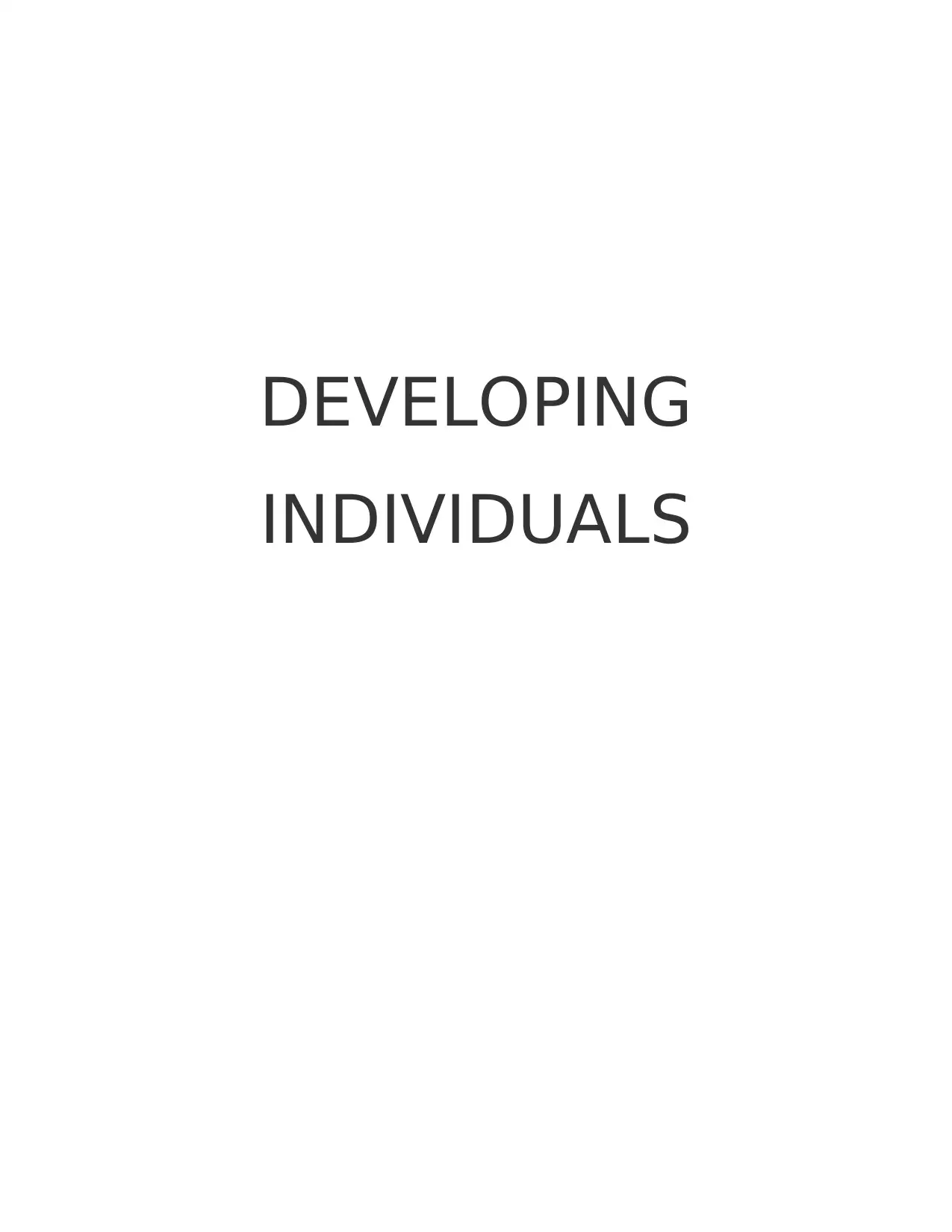
DEVELOPING
INDIVIDUALS
INDIVIDUALS
Secure Best Marks with AI Grader
Need help grading? Try our AI Grader for instant feedback on your assignments.
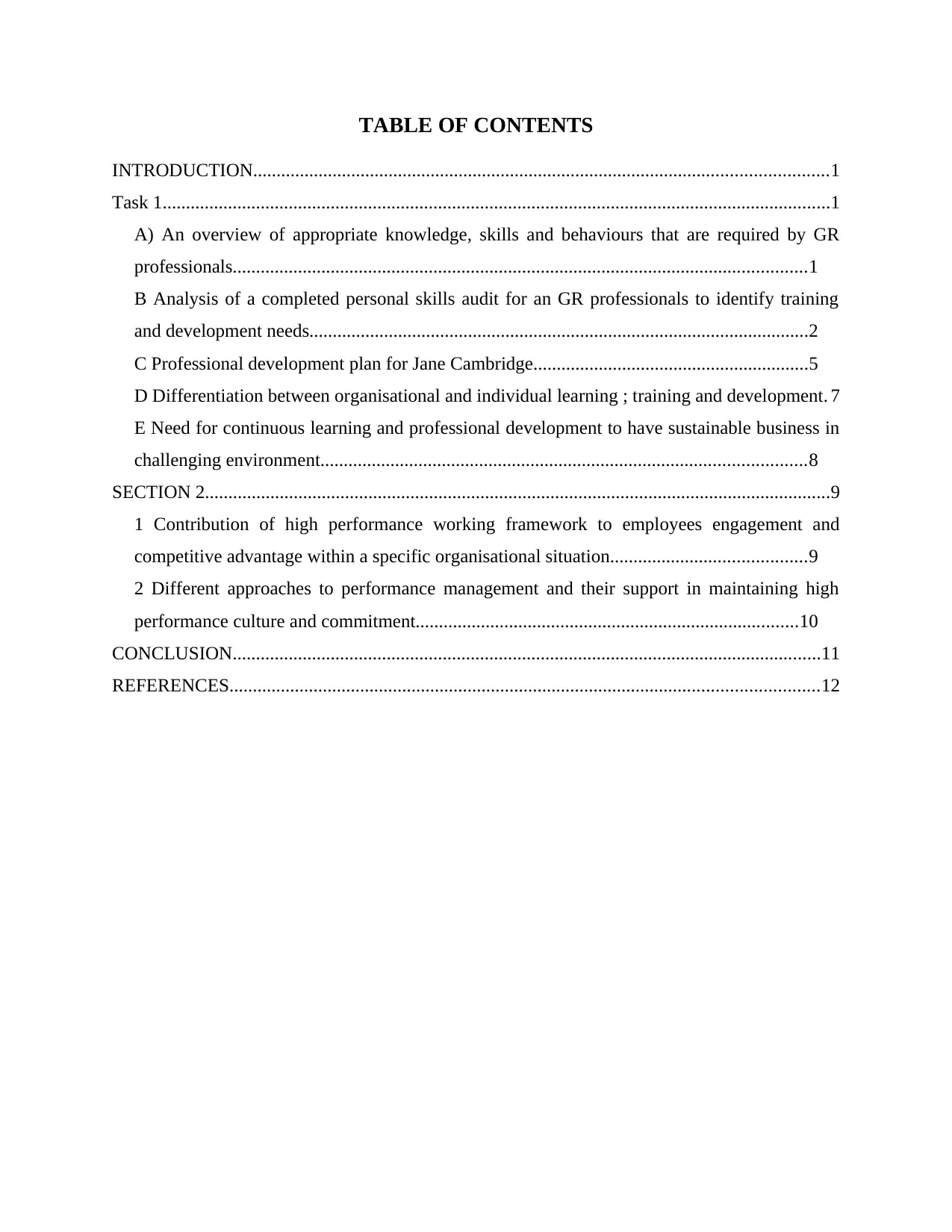
TABLE OF CONTENTS
INTRODUCTION...........................................................................................................................1
Task 1...............................................................................................................................................1
A) An overview of appropriate knowledge, skills and behaviours that are required by GR
professionals...........................................................................................................................1
B Analysis of a completed personal skills audit for an GR professionals to identify training
and development needs...........................................................................................................2
C Professional development plan for Jane Cambridge...........................................................5
D Differentiation between organisational and individual learning ; training and development. 7
E Need for continuous learning and professional development to have sustainable business in
challenging environment........................................................................................................8
SECTION 2......................................................................................................................................9
1 Contribution of high performance working framework to employees engagement and
competitive advantage within a specific organisational situation..........................................9
2 Different approaches to performance management and their support in maintaining high
performance culture and commitment..................................................................................10
CONCLUSION..............................................................................................................................11
REFERENCES..............................................................................................................................12
INTRODUCTION...........................................................................................................................1
Task 1...............................................................................................................................................1
A) An overview of appropriate knowledge, skills and behaviours that are required by GR
professionals...........................................................................................................................1
B Analysis of a completed personal skills audit for an GR professionals to identify training
and development needs...........................................................................................................2
C Professional development plan for Jane Cambridge...........................................................5
D Differentiation between organisational and individual learning ; training and development. 7
E Need for continuous learning and professional development to have sustainable business in
challenging environment........................................................................................................8
SECTION 2......................................................................................................................................9
1 Contribution of high performance working framework to employees engagement and
competitive advantage within a specific organisational situation..........................................9
2 Different approaches to performance management and their support in maintaining high
performance culture and commitment..................................................................................10
CONCLUSION..............................................................................................................................11
REFERENCES..............................................................................................................................12
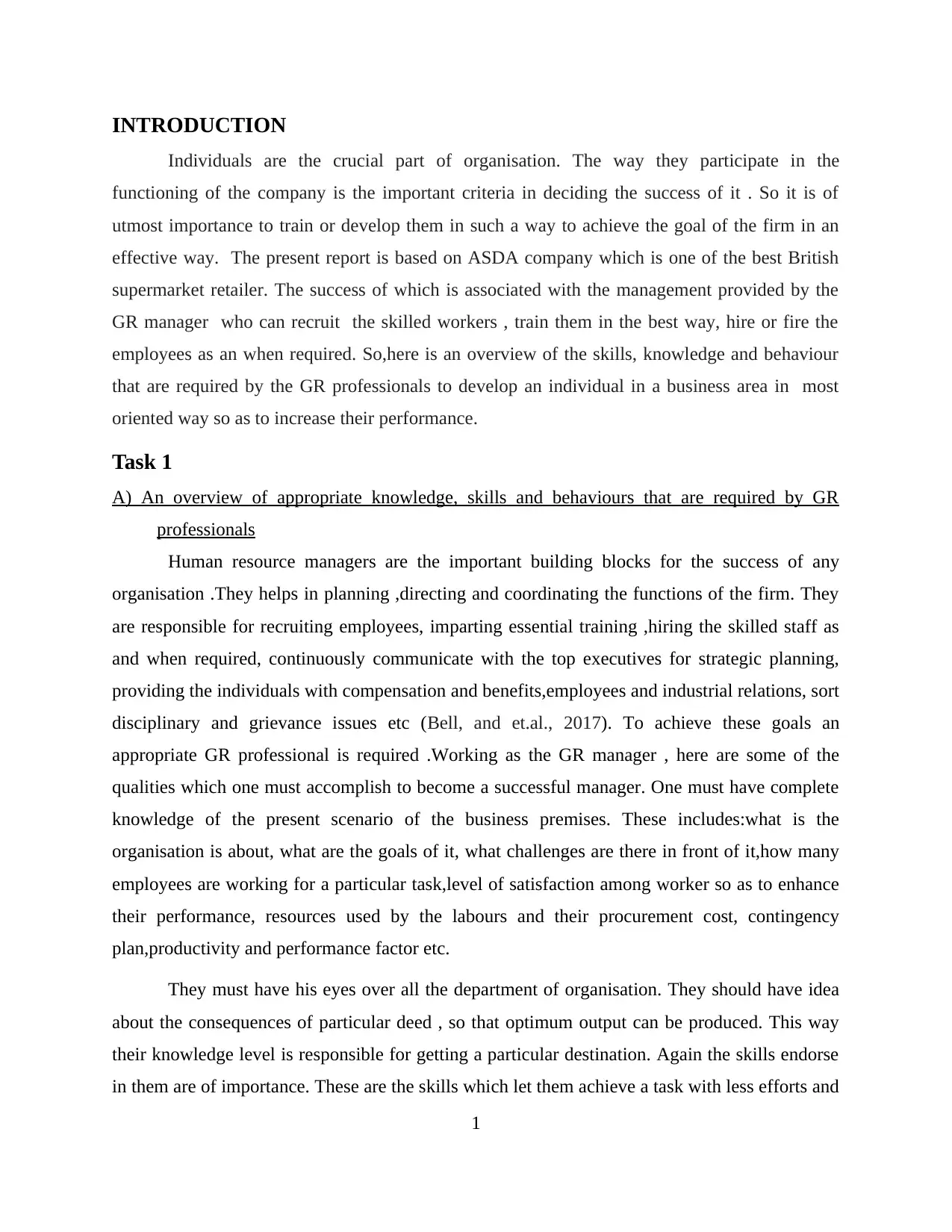
INTRODUCTION
Individuals are the crucial part of organisation. The way they participate in the
functioning of the company is the important criteria in deciding the success of it . So it is of
utmost importance to train or develop them in such a way to achieve the goal of the firm in an
effective way. The present report is based on ASDA company which is one of the best British
supermarket retailer. The success of which is associated with the management provided by the
GR manager who can recruit the skilled workers , train them in the best way, hire or fire the
employees as an when required. So,here is an overview of the skills, knowledge and behaviour
that are required by the GR professionals to develop an individual in a business area in most
oriented way so as to increase their performance.
Task 1
A) An overview of appropriate knowledge, skills and behaviours that are required by GR
professionals
Human resource managers are the important building blocks for the success of any
organisation .They helps in planning ,directing and coordinating the functions of the firm. They
are responsible for recruiting employees, imparting essential training ,hiring the skilled staff as
and when required, continuously communicate with the top executives for strategic planning,
providing the individuals with compensation and benefits,employees and industrial relations, sort
disciplinary and grievance issues etc (Bell, and et.al., 2017). To achieve these goals an
appropriate GR professional is required .Working as the GR manager , here are some of the
qualities which one must accomplish to become a successful manager. One must have complete
knowledge of the present scenario of the business premises. These includes:what is the
organisation is about, what are the goals of it, what challenges are there in front of it,how many
employees are working for a particular task,level of satisfaction among worker so as to enhance
their performance, resources used by the labours and their procurement cost, contingency
plan,productivity and performance factor etc.
They must have his eyes over all the department of organisation. They should have idea
about the consequences of particular deed , so that optimum output can be produced. This way
their knowledge level is responsible for getting a particular destination. Again the skills endorse
in them are of importance. These are the skills which let them achieve a task with less efforts and
1
Individuals are the crucial part of organisation. The way they participate in the
functioning of the company is the important criteria in deciding the success of it . So it is of
utmost importance to train or develop them in such a way to achieve the goal of the firm in an
effective way. The present report is based on ASDA company which is one of the best British
supermarket retailer. The success of which is associated with the management provided by the
GR manager who can recruit the skilled workers , train them in the best way, hire or fire the
employees as an when required. So,here is an overview of the skills, knowledge and behaviour
that are required by the GR professionals to develop an individual in a business area in most
oriented way so as to increase their performance.
Task 1
A) An overview of appropriate knowledge, skills and behaviours that are required by GR
professionals
Human resource managers are the important building blocks for the success of any
organisation .They helps in planning ,directing and coordinating the functions of the firm. They
are responsible for recruiting employees, imparting essential training ,hiring the skilled staff as
and when required, continuously communicate with the top executives for strategic planning,
providing the individuals with compensation and benefits,employees and industrial relations, sort
disciplinary and grievance issues etc (Bell, and et.al., 2017). To achieve these goals an
appropriate GR professional is required .Working as the GR manager , here are some of the
qualities which one must accomplish to become a successful manager. One must have complete
knowledge of the present scenario of the business premises. These includes:what is the
organisation is about, what are the goals of it, what challenges are there in front of it,how many
employees are working for a particular task,level of satisfaction among worker so as to enhance
their performance, resources used by the labours and their procurement cost, contingency
plan,productivity and performance factor etc.
They must have his eyes over all the department of organisation. They should have idea
about the consequences of particular deed , so that optimum output can be produced. This way
their knowledge level is responsible for getting a particular destination. Again the skills endorse
in them are of importance. These are the skills which let them achieve a task with less efforts and
1
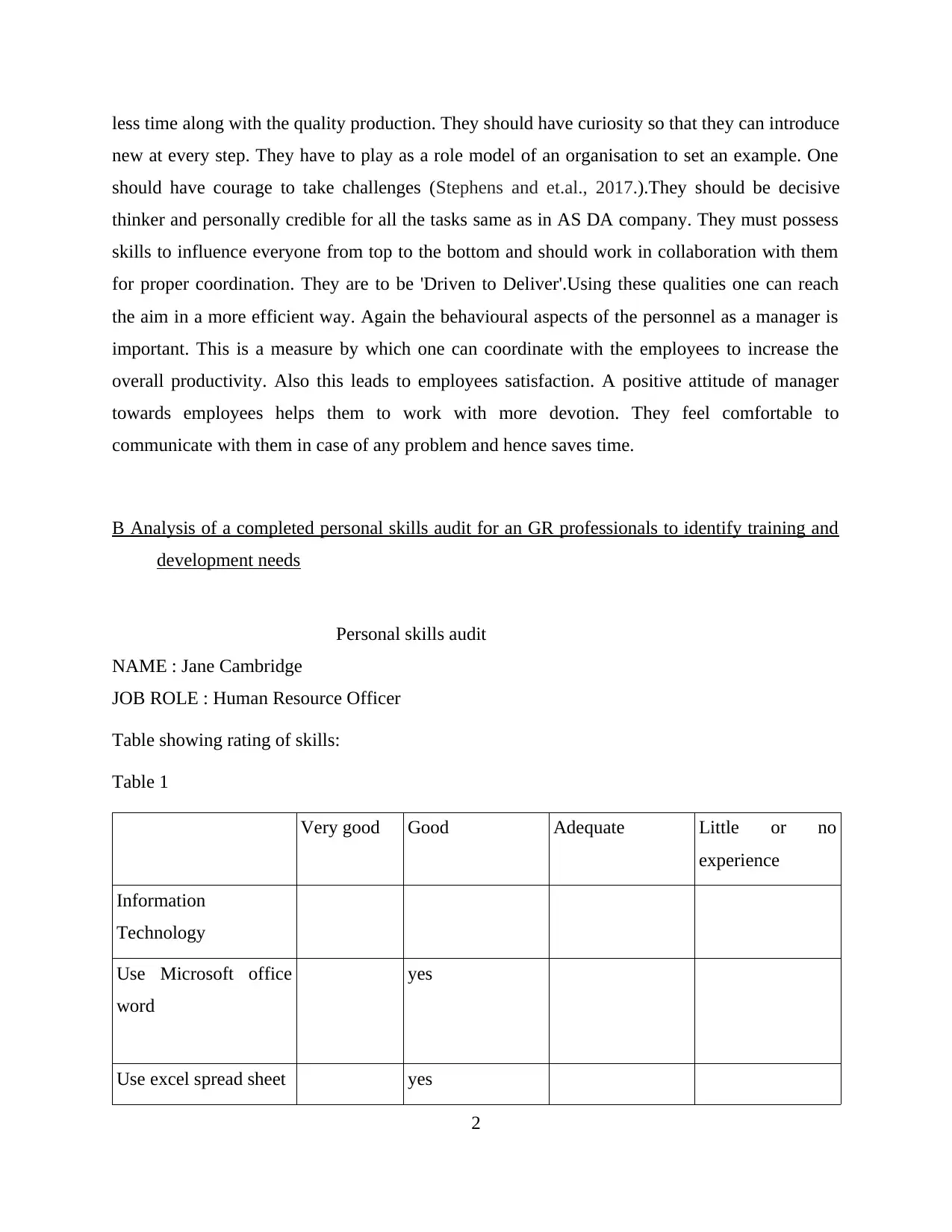
less time along with the quality production. They should have curiosity so that they can introduce
new at every step. They have to play as a role model of an organisation to set an example. One
should have courage to take challenges (Stephens and et.al., 2017.).They should be decisive
thinker and personally credible for all the tasks same as in AS DA company. They must possess
skills to influence everyone from top to the bottom and should work in collaboration with them
for proper coordination. They are to be 'Driven to Deliver'.Using these qualities one can reach
the aim in a more efficient way. Again the behavioural aspects of the personnel as a manager is
important. This is a measure by which one can coordinate with the employees to increase the
overall productivity. Also this leads to employees satisfaction. A positive attitude of manager
towards employees helps them to work with more devotion. They feel comfortable to
communicate with them in case of any problem and hence saves time.
B Analysis of a completed personal skills audit for an GR professionals to identify training and
development needs
Personal skills audit
NAME : Jane Cambridge
JOB ROLE : Human Resource Officer
Table showing rating of skills:
Table 1
Very good Good Adequate Little or no
experience
Information
Technology
Use Microsoft office
word
yes
Use excel spread sheet yes
2
new at every step. They have to play as a role model of an organisation to set an example. One
should have courage to take challenges (Stephens and et.al., 2017.).They should be decisive
thinker and personally credible for all the tasks same as in AS DA company. They must possess
skills to influence everyone from top to the bottom and should work in collaboration with them
for proper coordination. They are to be 'Driven to Deliver'.Using these qualities one can reach
the aim in a more efficient way. Again the behavioural aspects of the personnel as a manager is
important. This is a measure by which one can coordinate with the employees to increase the
overall productivity. Also this leads to employees satisfaction. A positive attitude of manager
towards employees helps them to work with more devotion. They feel comfortable to
communicate with them in case of any problem and hence saves time.
B Analysis of a completed personal skills audit for an GR professionals to identify training and
development needs
Personal skills audit
NAME : Jane Cambridge
JOB ROLE : Human Resource Officer
Table showing rating of skills:
Table 1
Very good Good Adequate Little or no
experience
Information
Technology
Use Microsoft office
word
yes
Use excel spread sheet yes
2
Secure Best Marks with AI Grader
Need help grading? Try our AI Grader for instant feedback on your assignments.
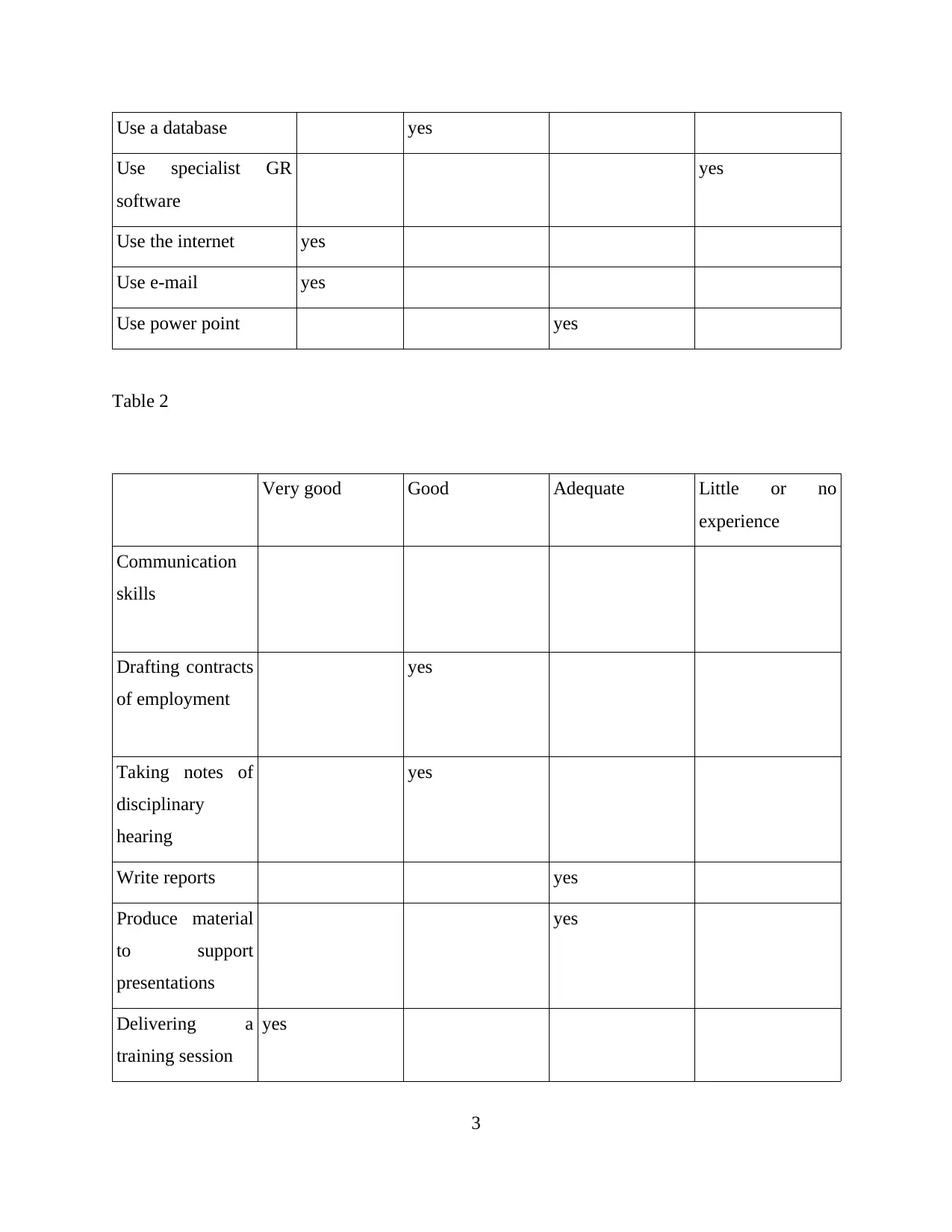
Use a database yes
Use specialist GR
software
yes
Use the internet yes
Use e-mail yes
Use power point yes
Table 2
Very good Good Adequate Little or no
experience
Communication
skills
Drafting contracts
of employment
yes
Taking notes of
disciplinary
hearing
yes
Write reports yes
Produce material
to support
presentations
yes
Delivering a
training session
yes
3
Use specialist GR
software
yes
Use the internet yes
Use e-mail yes
Use power point yes
Table 2
Very good Good Adequate Little or no
experience
Communication
skills
Drafting contracts
of employment
yes
Taking notes of
disciplinary
hearing
yes
Write reports yes
Produce material
to support
presentations
yes
Delivering a
training session
yes
3
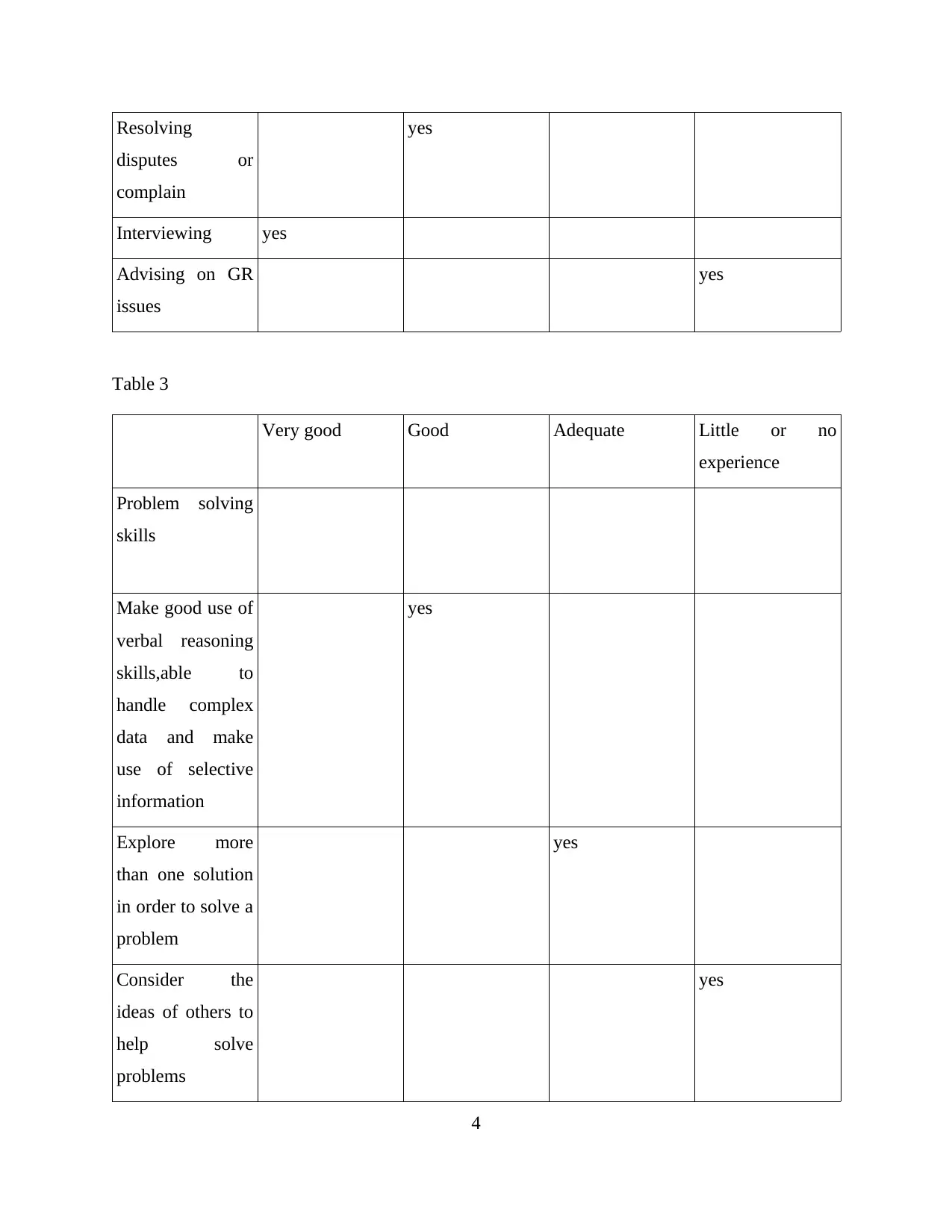
Resolving
disputes or
complain
yes
Interviewing yes
Advising on GR
issues
yes
Table 3
Very good Good Adequate Little or no
experience
Problem solving
skills
Make good use of
verbal reasoning
skills,able to
handle complex
data and make
use of selective
information
yes
Explore more
than one solution
in order to solve a
problem
yes
Consider the
ideas of others to
help solve
problems
yes
4
disputes or
complain
yes
Interviewing yes
Advising on GR
issues
yes
Table 3
Very good Good Adequate Little or no
experience
Problem solving
skills
Make good use of
verbal reasoning
skills,able to
handle complex
data and make
use of selective
information
yes
Explore more
than one solution
in order to solve a
problem
yes
Consider the
ideas of others to
help solve
problems
yes
4
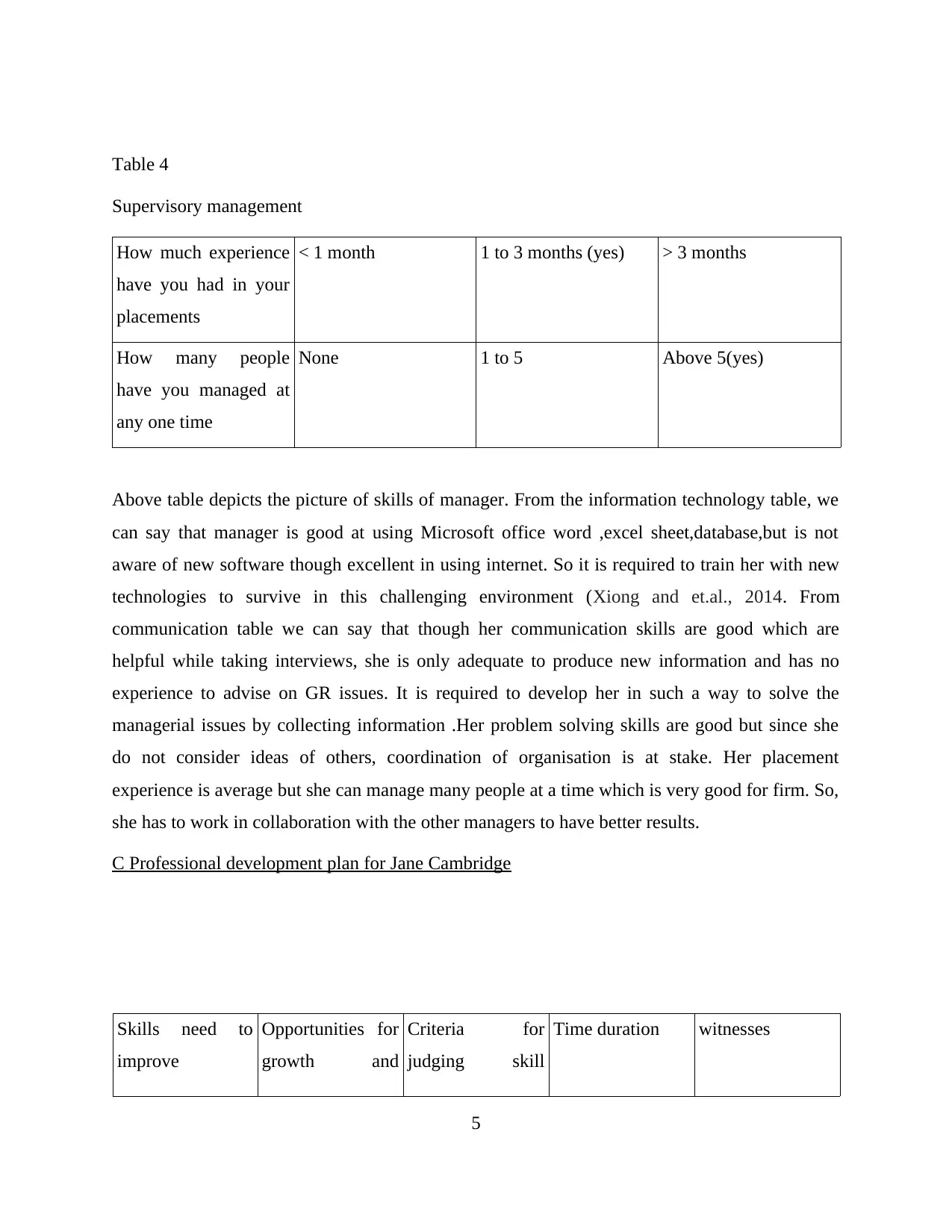
Table 4
Supervisory management
How much experience
have you had in your
placements
< 1 month 1 to 3 months (yes) > 3 months
How many people
have you managed at
any one time
None 1 to 5 Above 5(yes)
Above table depicts the picture of skills of manager. From the information technology table, we
can say that manager is good at using Microsoft office word ,excel sheet,database,but is not
aware of new software though excellent in using internet. So it is required to train her with new
technologies to survive in this challenging environment (Xiong and et.al., 2014. From
communication table we can say that though her communication skills are good which are
helpful while taking interviews, she is only adequate to produce new information and has no
experience to advise on GR issues. It is required to develop her in such a way to solve the
managerial issues by collecting information .Her problem solving skills are good but since she
do not consider ideas of others, coordination of organisation is at stake. Her placement
experience is average but she can manage many people at a time which is very good for firm. So,
she has to work in collaboration with the other managers to have better results.
C Professional development plan for Jane Cambridge
Skills need to
improve
Opportunities for
growth and
Criteria for
judging skill
Time duration witnesses
5
Supervisory management
How much experience
have you had in your
placements
< 1 month 1 to 3 months (yes) > 3 months
How many people
have you managed at
any one time
None 1 to 5 Above 5(yes)
Above table depicts the picture of skills of manager. From the information technology table, we
can say that manager is good at using Microsoft office word ,excel sheet,database,but is not
aware of new software though excellent in using internet. So it is required to train her with new
technologies to survive in this challenging environment (Xiong and et.al., 2014. From
communication table we can say that though her communication skills are good which are
helpful while taking interviews, she is only adequate to produce new information and has no
experience to advise on GR issues. It is required to develop her in such a way to solve the
managerial issues by collecting information .Her problem solving skills are good but since she
do not consider ideas of others, coordination of organisation is at stake. Her placement
experience is average but she can manage many people at a time which is very good for firm. So,
she has to work in collaboration with the other managers to have better results.
C Professional development plan for Jane Cambridge
Skills need to
improve
Opportunities for
growth and
Criteria for
judging skill
Time duration witnesses
5
Paraphrase This Document
Need a fresh take? Get an instant paraphrase of this document with our AI Paraphraser
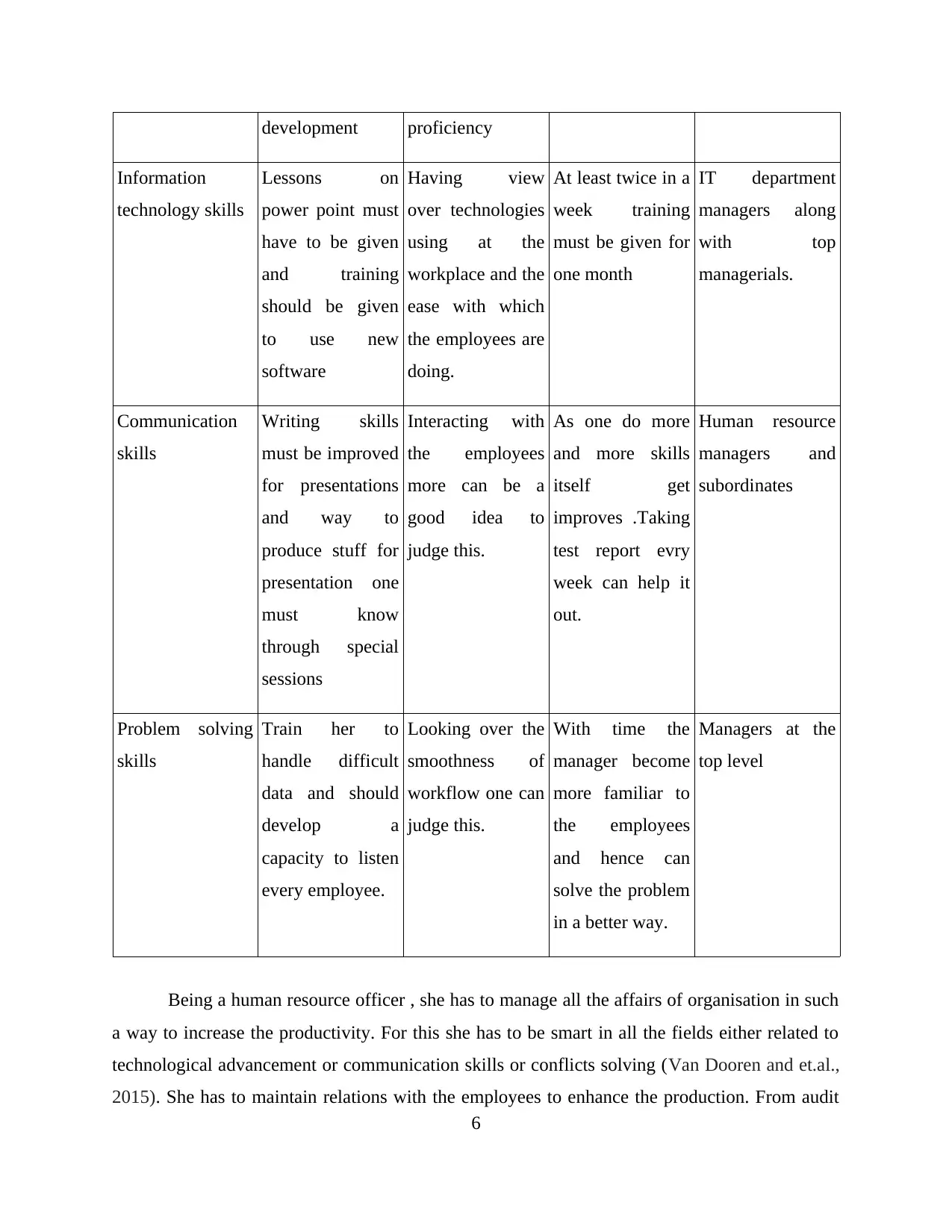
development proficiency
Information
technology skills
Lessons on
power point must
have to be given
and training
should be given
to use new
software
Having view
over technologies
using at the
workplace and the
ease with which
the employees are
doing.
At least twice in a
week training
must be given for
one month
IT department
managers along
with top
managerials.
Communication
skills
Writing skills
must be improved
for presentations
and way to
produce stuff for
presentation one
must know
through special
sessions
Interacting with
the employees
more can be a
good idea to
judge this.
As one do more
and more skills
itself get
improves .Taking
test report evry
week can help it
out.
Human resource
managers and
subordinates
Problem solving
skills
Train her to
handle difficult
data and should
develop a
capacity to listen
every employee.
Looking over the
smoothness of
workflow one can
judge this.
With time the
manager become
more familiar to
the employees
and hence can
solve the problem
in a better way.
Managers at the
top level
Being a human resource officer , she has to manage all the affairs of organisation in such
a way to increase the productivity. For this she has to be smart in all the fields either related to
technological advancement or communication skills or conflicts solving (Van Dooren and et.al.,
2015). She has to maintain relations with the employees to enhance the production. From audit
6
Information
technology skills
Lessons on
power point must
have to be given
and training
should be given
to use new
software
Having view
over technologies
using at the
workplace and the
ease with which
the employees are
doing.
At least twice in a
week training
must be given for
one month
IT department
managers along
with top
managerials.
Communication
skills
Writing skills
must be improved
for presentations
and way to
produce stuff for
presentation one
must know
through special
sessions
Interacting with
the employees
more can be a
good idea to
judge this.
As one do more
and more skills
itself get
improves .Taking
test report evry
week can help it
out.
Human resource
managers and
subordinates
Problem solving
skills
Train her to
handle difficult
data and should
develop a
capacity to listen
every employee.
Looking over the
smoothness of
workflow one can
judge this.
With time the
manager become
more familiar to
the employees
and hence can
solve the problem
in a better way.
Managers at the
top level
Being a human resource officer , she has to manage all the affairs of organisation in such
a way to increase the productivity. For this she has to be smart in all the fields either related to
technological advancement or communication skills or conflicts solving (Van Dooren and et.al.,
2015). She has to maintain relations with the employees to enhance the production. From audit
6
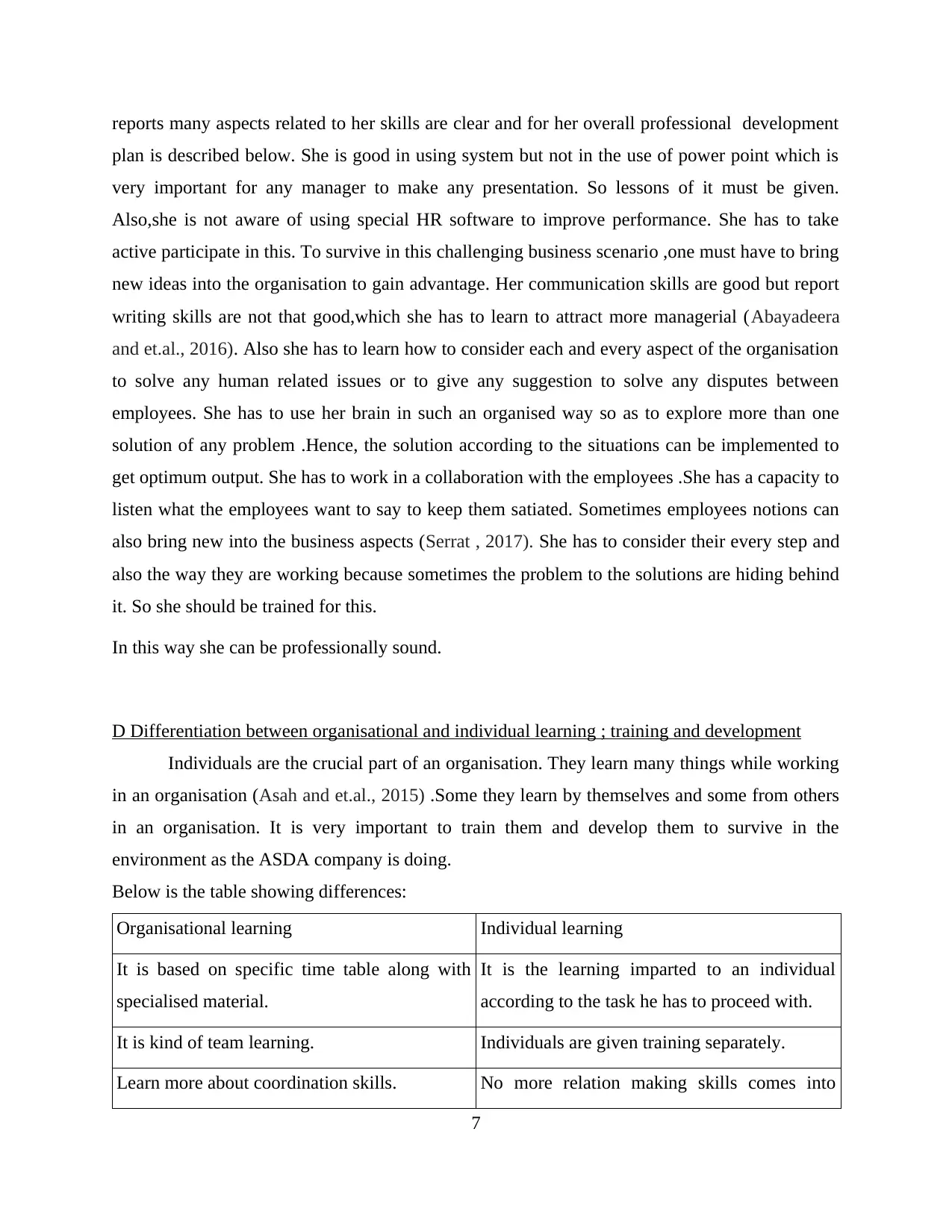
reports many aspects related to her skills are clear and for her overall professional development
plan is described below. She is good in using system but not in the use of power point which is
very important for any manager to make any presentation. So lessons of it must be given.
Also,she is not aware of using special HR software to improve performance. She has to take
active participate in this. To survive in this challenging business scenario ,one must have to bring
new ideas into the organisation to gain advantage. Her communication skills are good but report
writing skills are not that good,which she has to learn to attract more managerial (Abayadeera
and et.al., 2016). Also she has to learn how to consider each and every aspect of the organisation
to solve any human related issues or to give any suggestion to solve any disputes between
employees. She has to use her brain in such an organised way so as to explore more than one
solution of any problem .Hence, the solution according to the situations can be implemented to
get optimum output. She has to work in a collaboration with the employees .She has a capacity to
listen what the employees want to say to keep them satiated. Sometimes employees notions can
also bring new into the business aspects (Serrat , 2017). She has to consider their every step and
also the way they are working because sometimes the problem to the solutions are hiding behind
it. So she should be trained for this.
In this way she can be professionally sound.
D Differentiation between organisational and individual learning ; training and development
Individuals are the crucial part of an organisation. They learn many things while working
in an organisation (Asah and et.al., 2015) .Some they learn by themselves and some from others
in an organisation. It is very important to train them and develop them to survive in the
environment as the ASDA company is doing.
Below is the table showing differences:
Organisational learning Individual learning
It is based on specific time table along with
specialised material.
It is the learning imparted to an individual
according to the task he has to proceed with.
It is kind of team learning. Individuals are given training separately.
Learn more about coordination skills. No more relation making skills comes into
7
plan is described below. She is good in using system but not in the use of power point which is
very important for any manager to make any presentation. So lessons of it must be given.
Also,she is not aware of using special HR software to improve performance. She has to take
active participate in this. To survive in this challenging business scenario ,one must have to bring
new ideas into the organisation to gain advantage. Her communication skills are good but report
writing skills are not that good,which she has to learn to attract more managerial (Abayadeera
and et.al., 2016). Also she has to learn how to consider each and every aspect of the organisation
to solve any human related issues or to give any suggestion to solve any disputes between
employees. She has to use her brain in such an organised way so as to explore more than one
solution of any problem .Hence, the solution according to the situations can be implemented to
get optimum output. She has to work in a collaboration with the employees .She has a capacity to
listen what the employees want to say to keep them satiated. Sometimes employees notions can
also bring new into the business aspects (Serrat , 2017). She has to consider their every step and
also the way they are working because sometimes the problem to the solutions are hiding behind
it. So she should be trained for this.
In this way she can be professionally sound.
D Differentiation between organisational and individual learning ; training and development
Individuals are the crucial part of an organisation. They learn many things while working
in an organisation (Asah and et.al., 2015) .Some they learn by themselves and some from others
in an organisation. It is very important to train them and develop them to survive in the
environment as the ASDA company is doing.
Below is the table showing differences:
Organisational learning Individual learning
It is based on specific time table along with
specialised material.
It is the learning imparted to an individual
according to the task he has to proceed with.
It is kind of team learning. Individuals are given training separately.
Learn more about coordination skills. No more relation making skills comes into
7
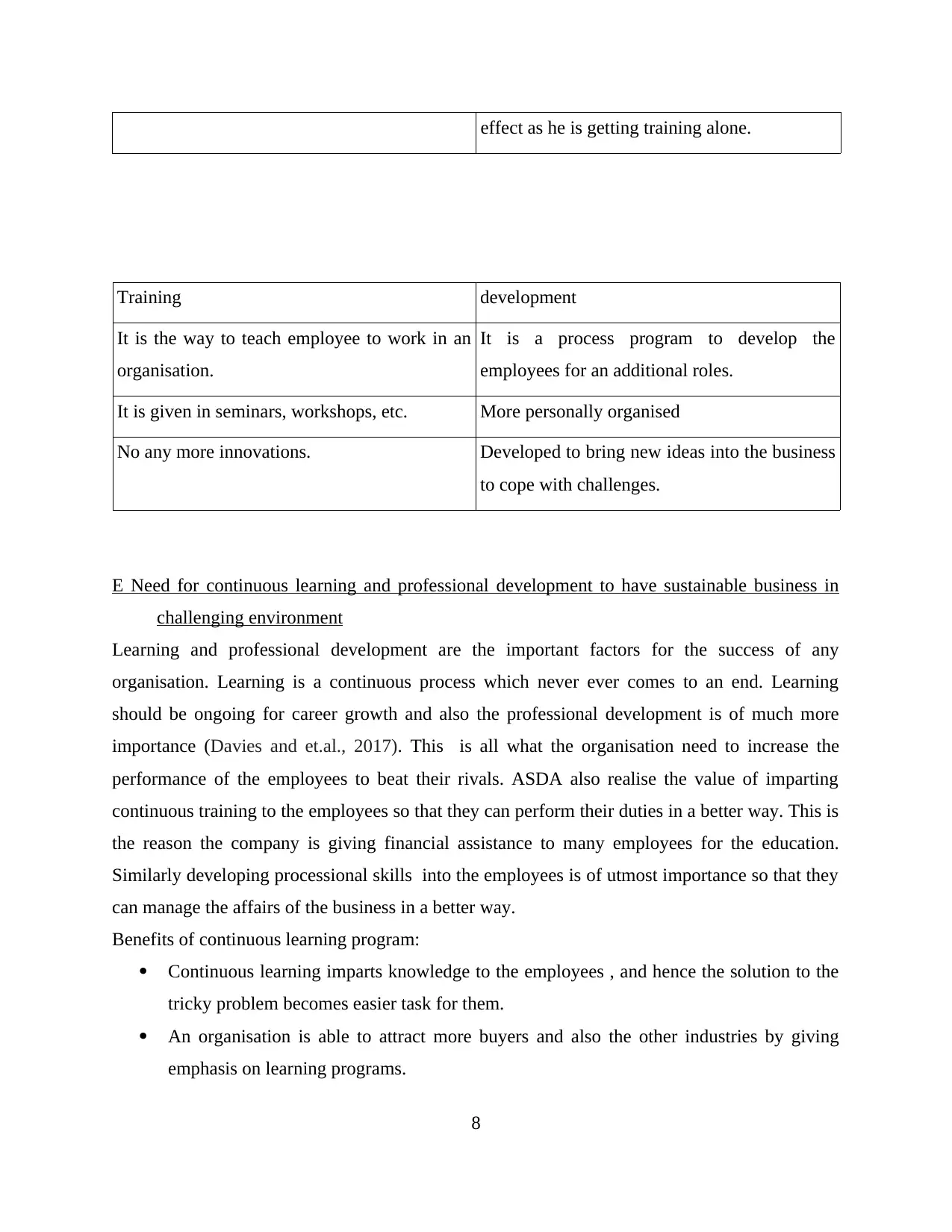
effect as he is getting training alone.
Training development
It is the way to teach employee to work in an
organisation.
It is a process program to develop the
employees for an additional roles.
It is given in seminars, workshops, etc. More personally organised
No any more innovations. Developed to bring new ideas into the business
to cope with challenges.
E Need for continuous learning and professional development to have sustainable business in
challenging environment
Learning and professional development are the important factors for the success of any
organisation. Learning is a continuous process which never ever comes to an end. Learning
should be ongoing for career growth and also the professional development is of much more
importance (Davies and et.al., 2017). This is all what the organisation need to increase the
performance of the employees to beat their rivals. ASDA also realise the value of imparting
continuous training to the employees so that they can perform their duties in a better way. This is
the reason the company is giving financial assistance to many employees for the education.
Similarly developing processional skills into the employees is of utmost importance so that they
can manage the affairs of the business in a better way.
Benefits of continuous learning program:
Continuous learning imparts knowledge to the employees , and hence the solution to the
tricky problem becomes easier task for them.
An organisation is able to attract more buyers and also the other industries by giving
emphasis on learning programs.
8
Training development
It is the way to teach employee to work in an
organisation.
It is a process program to develop the
employees for an additional roles.
It is given in seminars, workshops, etc. More personally organised
No any more innovations. Developed to bring new ideas into the business
to cope with challenges.
E Need for continuous learning and professional development to have sustainable business in
challenging environment
Learning and professional development are the important factors for the success of any
organisation. Learning is a continuous process which never ever comes to an end. Learning
should be ongoing for career growth and also the professional development is of much more
importance (Davies and et.al., 2017). This is all what the organisation need to increase the
performance of the employees to beat their rivals. ASDA also realise the value of imparting
continuous training to the employees so that they can perform their duties in a better way. This is
the reason the company is giving financial assistance to many employees for the education.
Similarly developing processional skills into the employees is of utmost importance so that they
can manage the affairs of the business in a better way.
Benefits of continuous learning program:
Continuous learning imparts knowledge to the employees , and hence the solution to the
tricky problem becomes easier task for them.
An organisation is able to attract more buyers and also the other industries by giving
emphasis on learning programs.
8
Secure Best Marks with AI Grader
Need help grading? Try our AI Grader for instant feedback on your assignments.
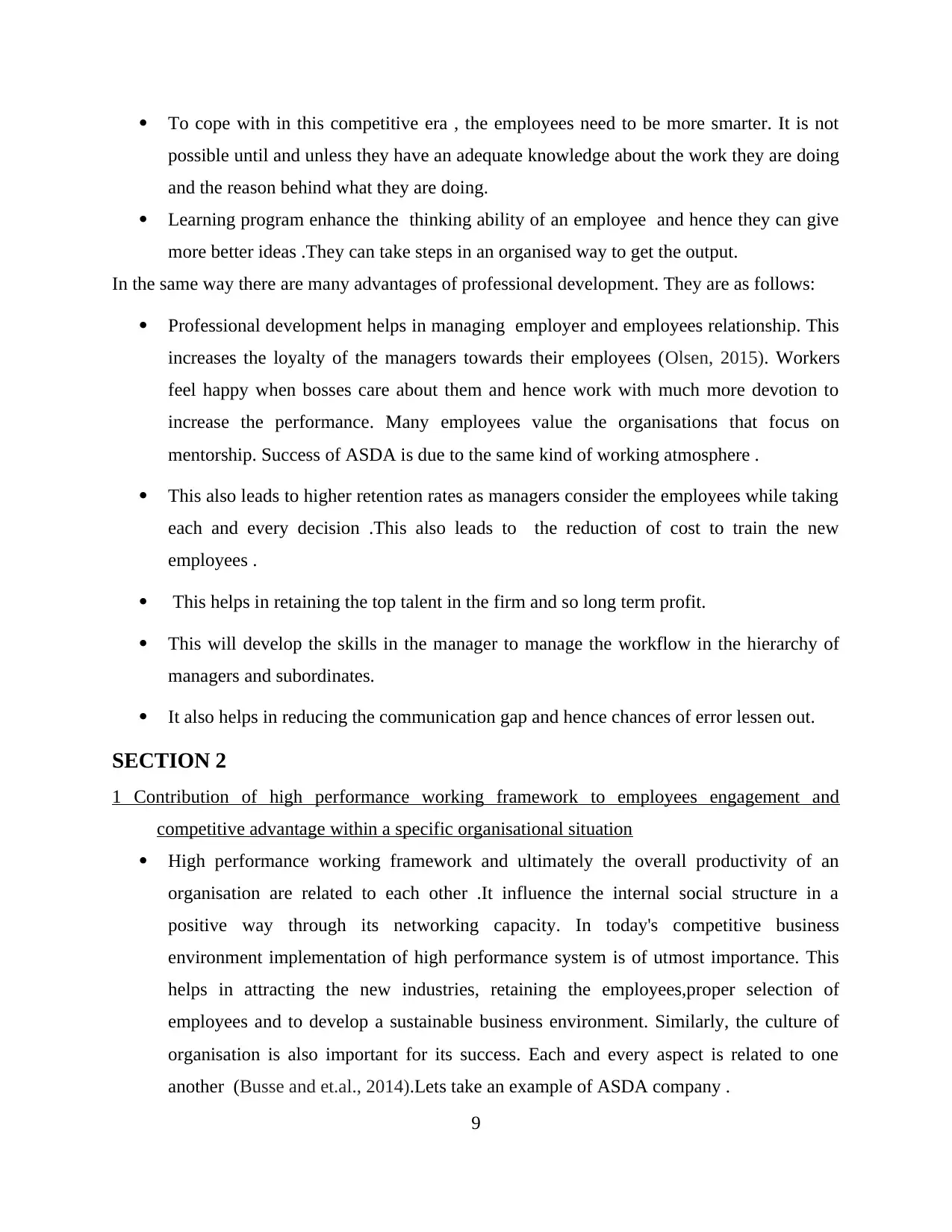
To cope with in this competitive era , the employees need to be more smarter. It is not
possible until and unless they have an adequate knowledge about the work they are doing
and the reason behind what they are doing.
Learning program enhance the thinking ability of an employee and hence they can give
more better ideas .They can take steps in an organised way to get the output.
In the same way there are many advantages of professional development. They are as follows:
Professional development helps in managing employer and employees relationship. This
increases the loyalty of the managers towards their employees (Olsen, 2015). Workers
feel happy when bosses care about them and hence work with much more devotion to
increase the performance. Many employees value the organisations that focus on
mentorship. Success of ASDA is due to the same kind of working atmosphere .
This also leads to higher retention rates as managers consider the employees while taking
each and every decision .This also leads to the reduction of cost to train the new
employees .
This helps in retaining the top talent in the firm and so long term profit.
This will develop the skills in the manager to manage the workflow in the hierarchy of
managers and subordinates.
It also helps in reducing the communication gap and hence chances of error lessen out.
SECTION 2
1 Contribution of high performance working framework to employees engagement and
competitive advantage within a specific organisational situation
High performance working framework and ultimately the overall productivity of an
organisation are related to each other .It influence the internal social structure in a
positive way through its networking capacity. In today's competitive business
environment implementation of high performance system is of utmost importance. This
helps in attracting the new industries, retaining the employees,proper selection of
employees and to develop a sustainable business environment. Similarly, the culture of
organisation is also important for its success. Each and every aspect is related to one
another (Busse and et.al., 2014).Lets take an example of ASDA company .
9
possible until and unless they have an adequate knowledge about the work they are doing
and the reason behind what they are doing.
Learning program enhance the thinking ability of an employee and hence they can give
more better ideas .They can take steps in an organised way to get the output.
In the same way there are many advantages of professional development. They are as follows:
Professional development helps in managing employer and employees relationship. This
increases the loyalty of the managers towards their employees (Olsen, 2015). Workers
feel happy when bosses care about them and hence work with much more devotion to
increase the performance. Many employees value the organisations that focus on
mentorship. Success of ASDA is due to the same kind of working atmosphere .
This also leads to higher retention rates as managers consider the employees while taking
each and every decision .This also leads to the reduction of cost to train the new
employees .
This helps in retaining the top talent in the firm and so long term profit.
This will develop the skills in the manager to manage the workflow in the hierarchy of
managers and subordinates.
It also helps in reducing the communication gap and hence chances of error lessen out.
SECTION 2
1 Contribution of high performance working framework to employees engagement and
competitive advantage within a specific organisational situation
High performance working framework and ultimately the overall productivity of an
organisation are related to each other .It influence the internal social structure in a
positive way through its networking capacity. In today's competitive business
environment implementation of high performance system is of utmost importance. This
helps in attracting the new industries, retaining the employees,proper selection of
employees and to develop a sustainable business environment. Similarly, the culture of
organisation is also important for its success. Each and every aspect is related to one
another (Busse and et.al., 2014).Lets take an example of ASDA company .
9
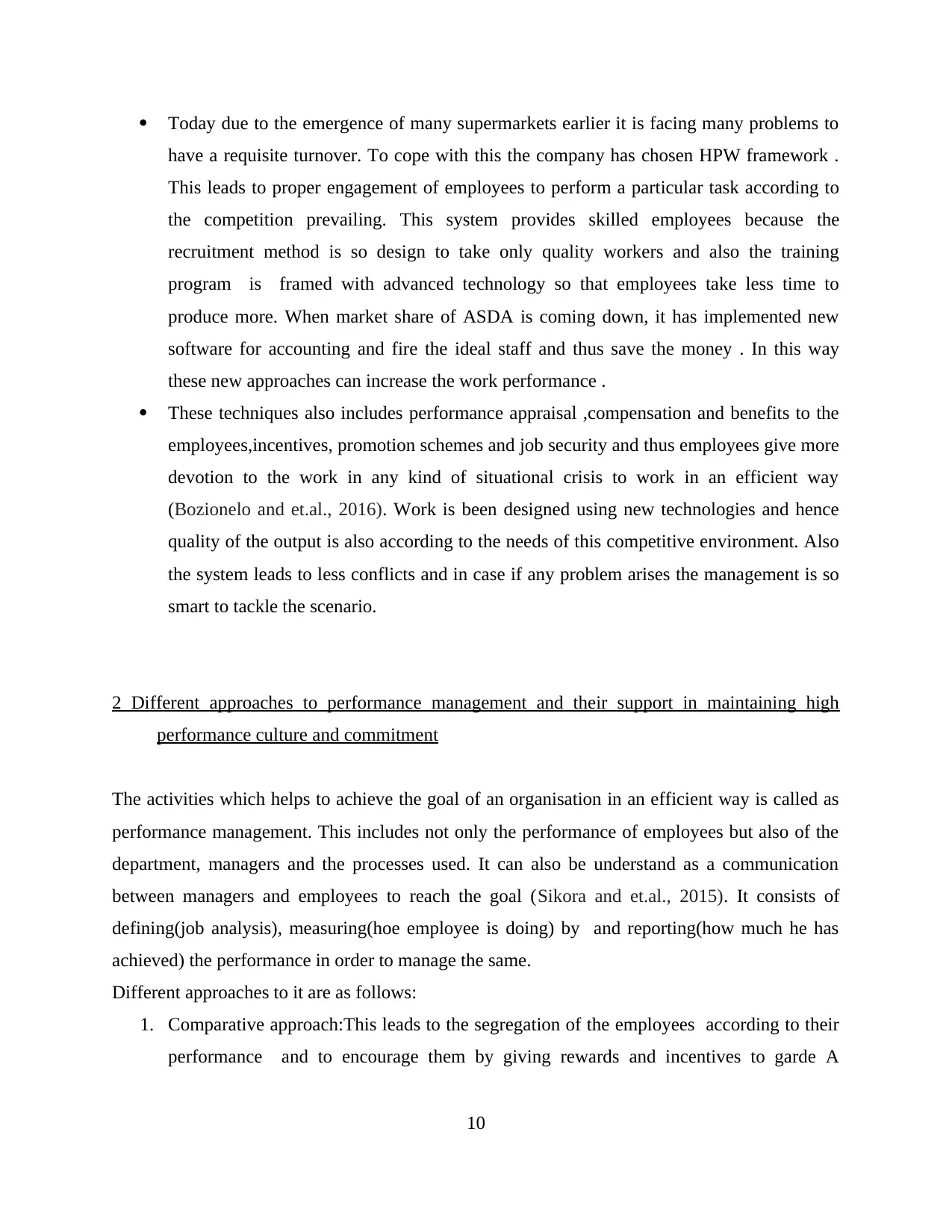
Today due to the emergence of many supermarkets earlier it is facing many problems to
have a requisite turnover. To cope with this the company has chosen HPW framework .
This leads to proper engagement of employees to perform a particular task according to
the competition prevailing. This system provides skilled employees because the
recruitment method is so design to take only quality workers and also the training
program is framed with advanced technology so that employees take less time to
produce more. When market share of ASDA is coming down, it has implemented new
software for accounting and fire the ideal staff and thus save the money . In this way
these new approaches can increase the work performance .
These techniques also includes performance appraisal ,compensation and benefits to the
employees,incentives, promotion schemes and job security and thus employees give more
devotion to the work in any kind of situational crisis to work in an efficient way
(Bozionelo and et.al., 2016). Work is been designed using new technologies and hence
quality of the output is also according to the needs of this competitive environment. Also
the system leads to less conflicts and in case if any problem arises the management is so
smart to tackle the scenario.
2 Different approaches to performance management and their support in maintaining high
performance culture and commitment
The activities which helps to achieve the goal of an organisation in an efficient way is called as
performance management. This includes not only the performance of employees but also of the
department, managers and the processes used. It can also be understand as a communication
between managers and employees to reach the goal (Sikora and et.al., 2015). It consists of
defining(job analysis), measuring(hoe employee is doing) by and reporting(how much he has
achieved) the performance in order to manage the same.
Different approaches to it are as follows:
1. Comparative approach:This leads to the segregation of the employees according to their
performance and to encourage them by giving rewards and incentives to garde A
10
have a requisite turnover. To cope with this the company has chosen HPW framework .
This leads to proper engagement of employees to perform a particular task according to
the competition prevailing. This system provides skilled employees because the
recruitment method is so design to take only quality workers and also the training
program is framed with advanced technology so that employees take less time to
produce more. When market share of ASDA is coming down, it has implemented new
software for accounting and fire the ideal staff and thus save the money . In this way
these new approaches can increase the work performance .
These techniques also includes performance appraisal ,compensation and benefits to the
employees,incentives, promotion schemes and job security and thus employees give more
devotion to the work in any kind of situational crisis to work in an efficient way
(Bozionelo and et.al., 2016). Work is been designed using new technologies and hence
quality of the output is also according to the needs of this competitive environment. Also
the system leads to less conflicts and in case if any problem arises the management is so
smart to tackle the scenario.
2 Different approaches to performance management and their support in maintaining high
performance culture and commitment
The activities which helps to achieve the goal of an organisation in an efficient way is called as
performance management. This includes not only the performance of employees but also of the
department, managers and the processes used. It can also be understand as a communication
between managers and employees to reach the goal (Sikora and et.al., 2015). It consists of
defining(job analysis), measuring(hoe employee is doing) by and reporting(how much he has
achieved) the performance in order to manage the same.
Different approaches to it are as follows:
1. Comparative approach:This leads to the segregation of the employees according to their
performance and to encourage them by giving rewards and incentives to garde A
10
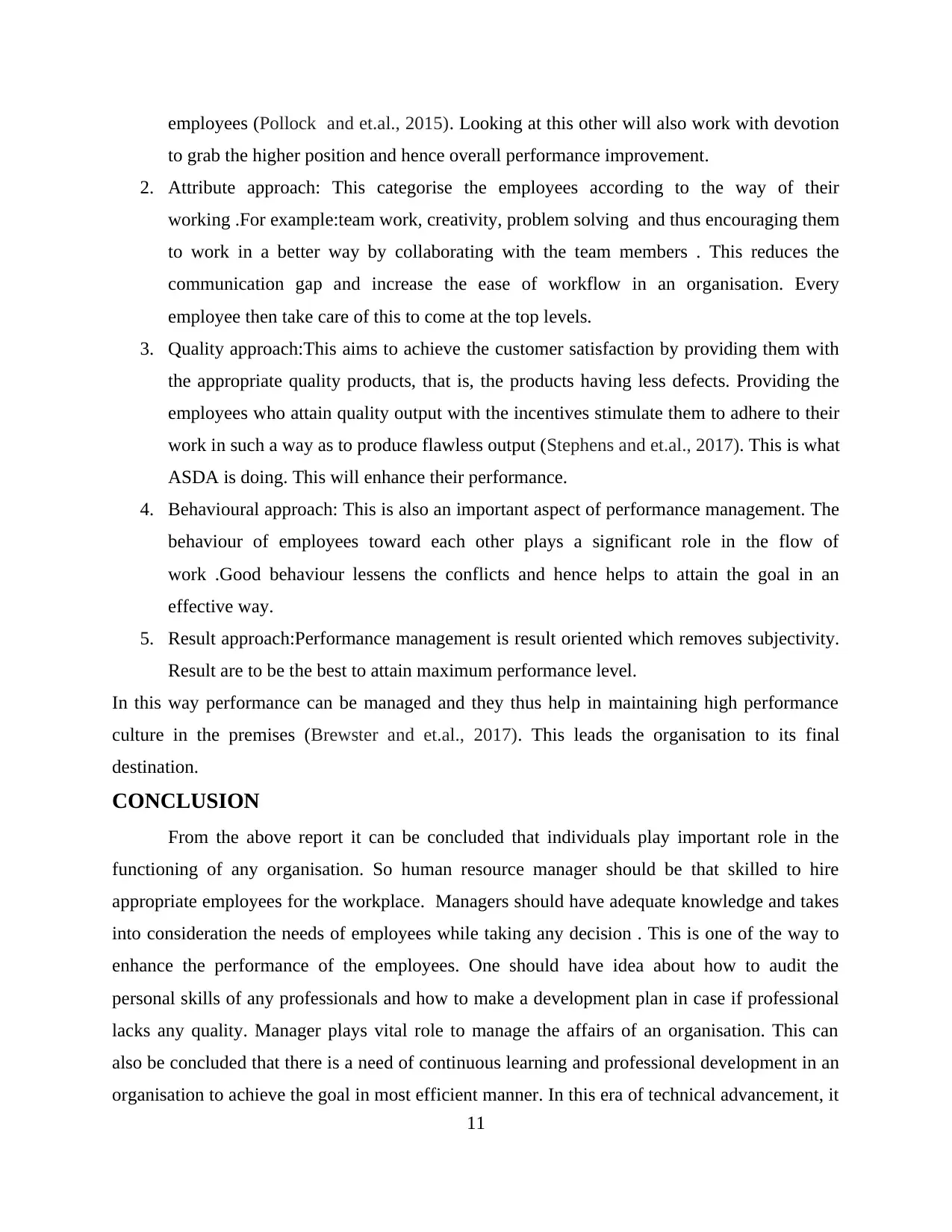
employees (Pollock and et.al., 2015). Looking at this other will also work with devotion
to grab the higher position and hence overall performance improvement.
2. Attribute approach: This categorise the employees according to the way of their
working .For example:team work, creativity, problem solving and thus encouraging them
to work in a better way by collaborating with the team members . This reduces the
communication gap and increase the ease of workflow in an organisation. Every
employee then take care of this to come at the top levels.
3. Quality approach:This aims to achieve the customer satisfaction by providing them with
the appropriate quality products, that is, the products having less defects. Providing the
employees who attain quality output with the incentives stimulate them to adhere to their
work in such a way as to produce flawless output (Stephens and et.al., 2017). This is what
ASDA is doing. This will enhance their performance.
4. Behavioural approach: This is also an important aspect of performance management. The
behaviour of employees toward each other plays a significant role in the flow of
work .Good behaviour lessens the conflicts and hence helps to attain the goal in an
effective way.
5. Result approach:Performance management is result oriented which removes subjectivity.
Result are to be the best to attain maximum performance level.
In this way performance can be managed and they thus help in maintaining high performance
culture in the premises (Brewster and et.al., 2017). This leads the organisation to its final
destination.
CONCLUSION
From the above report it can be concluded that individuals play important role in the
functioning of any organisation. So human resource manager should be that skilled to hire
appropriate employees for the workplace. Managers should have adequate knowledge and takes
into consideration the needs of employees while taking any decision . This is one of the way to
enhance the performance of the employees. One should have idea about how to audit the
personal skills of any professionals and how to make a development plan in case if professional
lacks any quality. Manager plays vital role to manage the affairs of an organisation. This can
also be concluded that there is a need of continuous learning and professional development in an
organisation to achieve the goal in most efficient manner. In this era of technical advancement, it
11
to grab the higher position and hence overall performance improvement.
2. Attribute approach: This categorise the employees according to the way of their
working .For example:team work, creativity, problem solving and thus encouraging them
to work in a better way by collaborating with the team members . This reduces the
communication gap and increase the ease of workflow in an organisation. Every
employee then take care of this to come at the top levels.
3. Quality approach:This aims to achieve the customer satisfaction by providing them with
the appropriate quality products, that is, the products having less defects. Providing the
employees who attain quality output with the incentives stimulate them to adhere to their
work in such a way as to produce flawless output (Stephens and et.al., 2017). This is what
ASDA is doing. This will enhance their performance.
4. Behavioural approach: This is also an important aspect of performance management. The
behaviour of employees toward each other plays a significant role in the flow of
work .Good behaviour lessens the conflicts and hence helps to attain the goal in an
effective way.
5. Result approach:Performance management is result oriented which removes subjectivity.
Result are to be the best to attain maximum performance level.
In this way performance can be managed and they thus help in maintaining high performance
culture in the premises (Brewster and et.al., 2017). This leads the organisation to its final
destination.
CONCLUSION
From the above report it can be concluded that individuals play important role in the
functioning of any organisation. So human resource manager should be that skilled to hire
appropriate employees for the workplace. Managers should have adequate knowledge and takes
into consideration the needs of employees while taking any decision . This is one of the way to
enhance the performance of the employees. One should have idea about how to audit the
personal skills of any professionals and how to make a development plan in case if professional
lacks any quality. Manager plays vital role to manage the affairs of an organisation. This can
also be concluded that there is a need of continuous learning and professional development in an
organisation to achieve the goal in most efficient manner. In this era of technical advancement, it
11
Paraphrase This Document
Need a fresh take? Get an instant paraphrase of this document with our AI Paraphraser
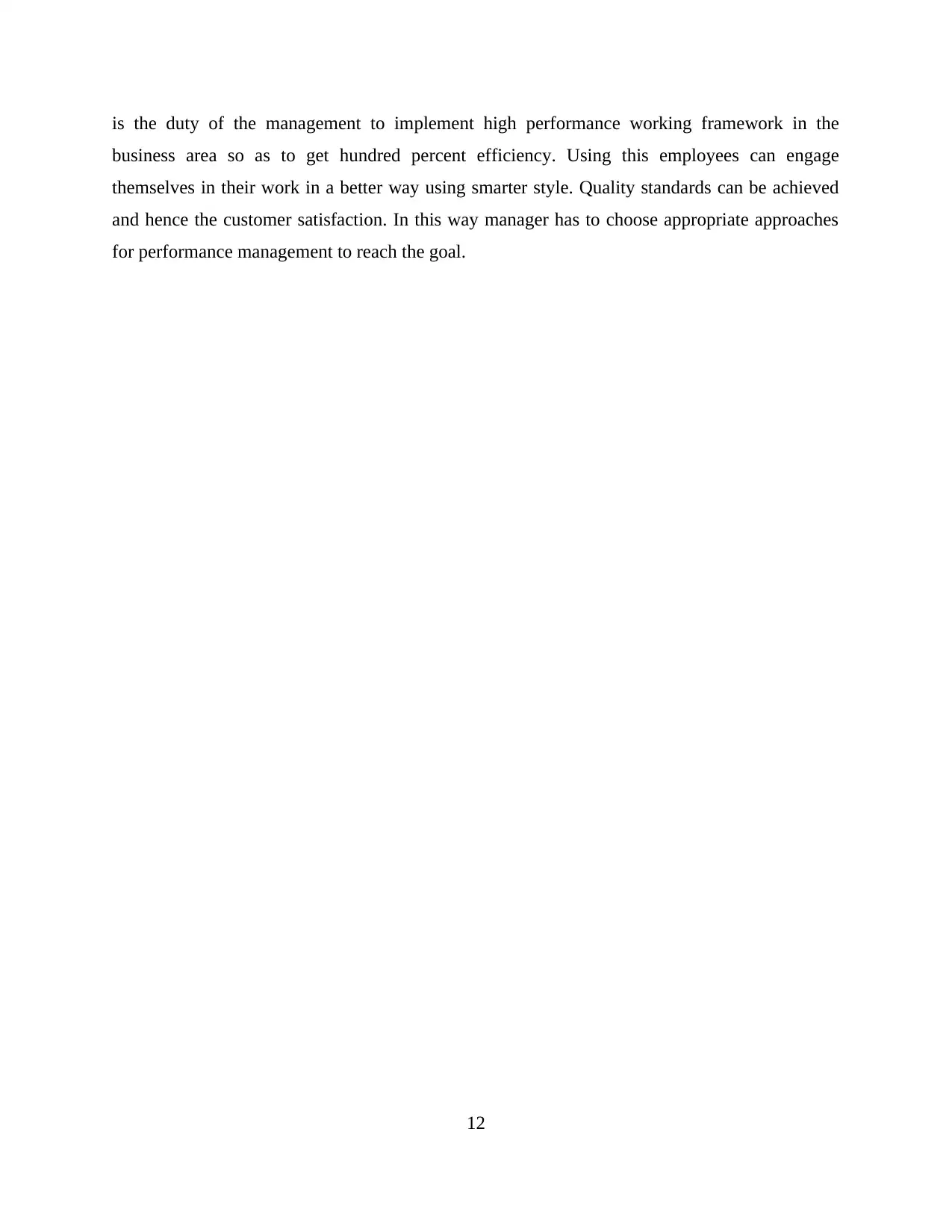
is the duty of the management to implement high performance working framework in the
business area so as to get hundred percent efficiency. Using this employees can engage
themselves in their work in a better way using smarter style. Quality standards can be achieved
and hence the customer satisfaction. In this way manager has to choose appropriate approaches
for performance management to reach the goal.
12
business area so as to get hundred percent efficiency. Using this employees can engage
themselves in their work in a better way using smarter style. Quality standards can be achieved
and hence the customer satisfaction. In this way manager has to choose appropriate approaches
for performance management to reach the goal.
12
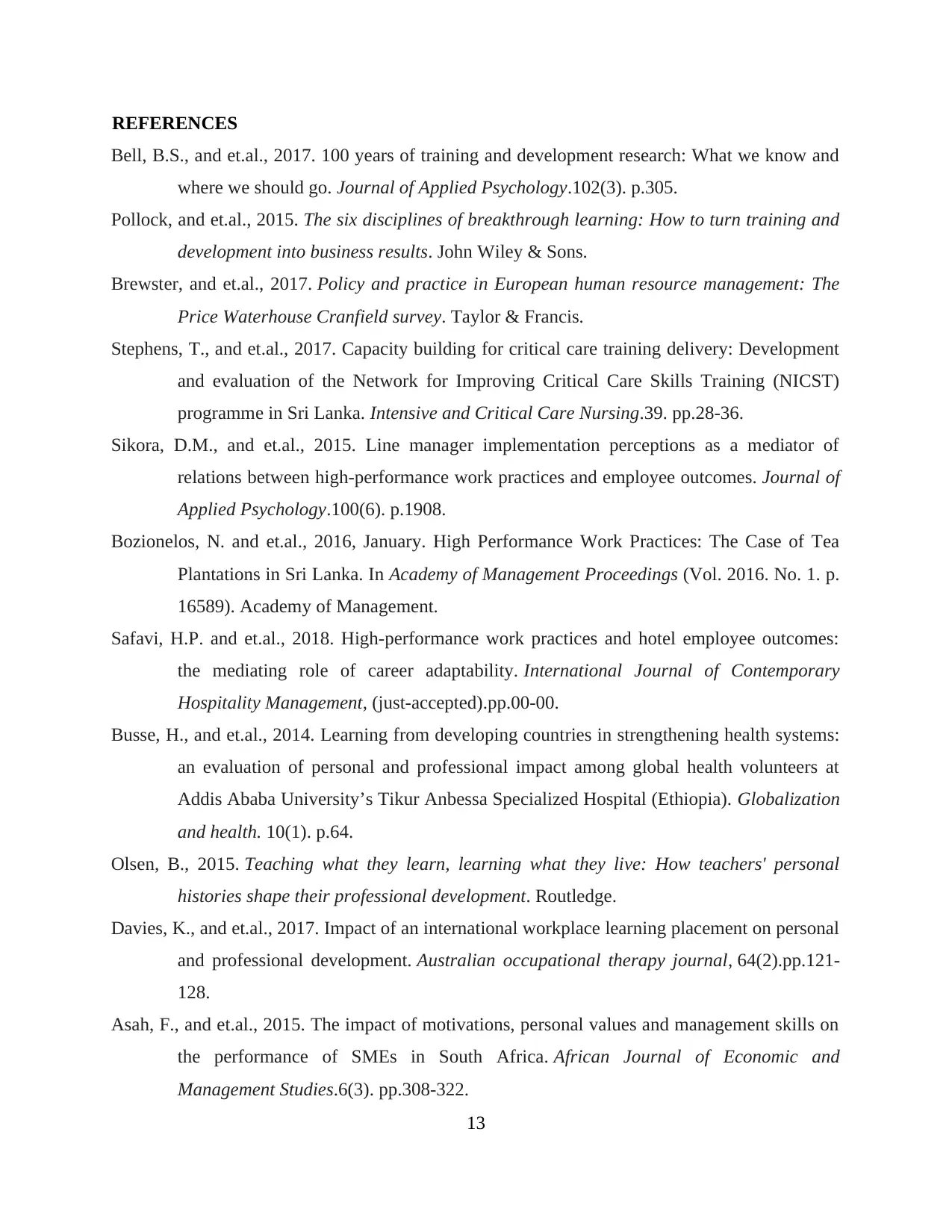
REFERENCES
Bell, B.S., and et.al., 2017. 100 years of training and development research: What we know and
where we should go. Journal of Applied Psychology.102(3). p.305.
Pollock, and et.al., 2015. The six disciplines of breakthrough learning: How to turn training and
development into business results. John Wiley & Sons.
Brewster, and et.al., 2017. Policy and practice in European human resource management: The
Price Waterhouse Cranfield survey. Taylor & Francis.
Stephens, T., and et.al., 2017. Capacity building for critical care training delivery: Development
and evaluation of the Network for Improving Critical Care Skills Training (NICST)
programme in Sri Lanka. Intensive and Critical Care Nursing.39. pp.28-36.
Sikora, D.M., and et.al., 2015. Line manager implementation perceptions as a mediator of
relations between high-performance work practices and employee outcomes. Journal of
Applied Psychology.100(6). p.1908.
Bozionelos, N. and et.al., 2016, January. High Performance Work Practices: The Case of Tea
Plantations in Sri Lanka. In Academy of Management Proceedings (Vol. 2016. No. 1. p.
16589). Academy of Management.
Safavi, H.P. and et.al., 2018. High-performance work practices and hotel employee outcomes:
the mediating role of career adaptability. International Journal of Contemporary
Hospitality Management, (just-accepted).pp.00-00.
Busse, H., and et.al., 2014. Learning from developing countries in strengthening health systems:
an evaluation of personal and professional impact among global health volunteers at
Addis Ababa University’s Tikur Anbessa Specialized Hospital (Ethiopia). Globalization
and health. 10(1). p.64.
Olsen, B., 2015. Teaching what they learn, learning what they live: How teachers' personal
histories shape their professional development. Routledge.
Davies, K., and et.al., 2017. Impact of an international workplace learning placement on personal
and professional development. Australian occupational therapy journal, 64(2).pp.121-
128.
Asah, F., and et.al., 2015. The impact of motivations, personal values and management skills on
the performance of SMEs in South Africa. African Journal of Economic and
Management Studies.6(3). pp.308-322.
13
Bell, B.S., and et.al., 2017. 100 years of training and development research: What we know and
where we should go. Journal of Applied Psychology.102(3). p.305.
Pollock, and et.al., 2015. The six disciplines of breakthrough learning: How to turn training and
development into business results. John Wiley & Sons.
Brewster, and et.al., 2017. Policy and practice in European human resource management: The
Price Waterhouse Cranfield survey. Taylor & Francis.
Stephens, T., and et.al., 2017. Capacity building for critical care training delivery: Development
and evaluation of the Network for Improving Critical Care Skills Training (NICST)
programme in Sri Lanka. Intensive and Critical Care Nursing.39. pp.28-36.
Sikora, D.M., and et.al., 2015. Line manager implementation perceptions as a mediator of
relations between high-performance work practices and employee outcomes. Journal of
Applied Psychology.100(6). p.1908.
Bozionelos, N. and et.al., 2016, January. High Performance Work Practices: The Case of Tea
Plantations in Sri Lanka. In Academy of Management Proceedings (Vol. 2016. No. 1. p.
16589). Academy of Management.
Safavi, H.P. and et.al., 2018. High-performance work practices and hotel employee outcomes:
the mediating role of career adaptability. International Journal of Contemporary
Hospitality Management, (just-accepted).pp.00-00.
Busse, H., and et.al., 2014. Learning from developing countries in strengthening health systems:
an evaluation of personal and professional impact among global health volunteers at
Addis Ababa University’s Tikur Anbessa Specialized Hospital (Ethiopia). Globalization
and health. 10(1). p.64.
Olsen, B., 2015. Teaching what they learn, learning what they live: How teachers' personal
histories shape their professional development. Routledge.
Davies, K., and et.al., 2017. Impact of an international workplace learning placement on personal
and professional development. Australian occupational therapy journal, 64(2).pp.121-
128.
Asah, F., and et.al., 2015. The impact of motivations, personal values and management skills on
the performance of SMEs in South Africa. African Journal of Economic and
Management Studies.6(3). pp.308-322.
13
1 out of 15
Related Documents
Your All-in-One AI-Powered Toolkit for Academic Success.
+13062052269
info@desklib.com
Available 24*7 on WhatsApp / Email
![[object Object]](/_next/static/media/star-bottom.7253800d.svg)
Unlock your academic potential
© 2024 | Zucol Services PVT LTD | All rights reserved.




